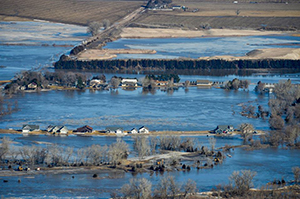FLOOD INFORMATION AND HELPFUL LINKS
PROTECT YOURSELF AND YOUR FAMILY
Here's what you can do to stay safe during a flood:
At Home
- If water rises in your home before you evacuate, go to the top floor, attic or roof.
- Listen to a battery-operated radio for the latest storm information.
- Turn off all utilities at the main power switch and close the main gas valve if advised to do so.
- If you've come in contact with floodwaters, wash your hands with soap and disinfected water.
When Outside
- Turn Around, Don’t Drown!
- Avoid walking or driving through flood waters. Just six inches of moving water can knock you down, and two feet of water can sweep your vehicle away.
- If there is a chance of flash flooding, move immediately to higher ground and avoid areas subject to flooding. Flash floods are the No. 1 cause of weather-related deaths in the U.S.
- If floodwaters rise around your car but the water is not moving, abandon the car and move to higher ground. Do not leave the car and enter moving water.
- Avoid camping or parking along streams, rivers, and creeks during heavy rainfall. These areas can flood quickly and with little warning.
Know Your Risks
Flood Watch
Be Aware. Conditions are right for flooding in your area.
Flood Warning
Take Action. Flooding is either happening or will happen shortly.
 Flash Flooding:
Flash Flooding:
- Floods kill more people on average than tornadoes and lightning combined. Most flood deaths are due to flash floods.
- Flash floods are often the result of heavy rains associated with severe thunderstorms. You will not always have a warning that these deadly, sudden floods are coming.
- When a flash flood WATCH is issued, be alert and be ready to evacuate on a moment's notice.
- When a flash flood WARNING is issued, or the moment you realize a flash flood is imminent, act quickly to save yourself. You may only have SECONDS.
- Nearly half of all flash flood fatalities are automobile related. In your auto, look out for flooding at highway dips, bridges or low areas.
- DO NOT drive through flowing water. A mere two feet of water will carry away most automobiles.
 To find out how to help or donate, call 211.
To find out how to help or donate, call 211.
QUICK LINKS
Severe Weather and Flooding - DHHS
Nebraska Floodplain Interactive
FEMA National Flood Hazard Layer
FEMA Flood Map Service Center
NOAA Flood Stage Map
USGS Water Alert System
Flood Insurance Resources
National Flood Insurance Program
Flood Insurance Claims Handbook
State Response Agencies
Nebraska Emergency Management Agency
Nebraska Department of Roads
Nebraska Department of Insurance
Department of Health and Human Services - Flooding Page
Nebraska Department of Environmental Quality
Additional Resources
Red Cross
Salvation Army - Omaha
Avoid Scams After A Disaster
River Levels
US Army Corp of Engineers
Missouri River Basin Water Management
US Geological Survey Water Watch
USGS WaterAlert
Farm Service Agency
Disaster Education - University of Nebraska